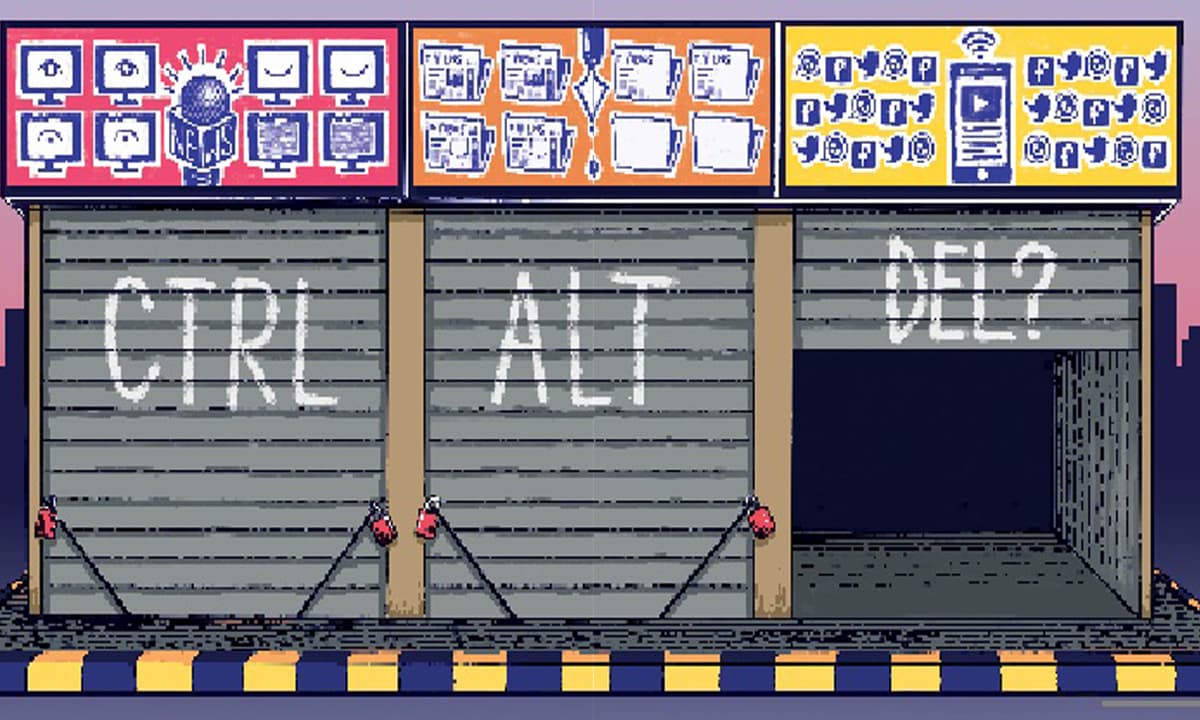First off, let me briefly define social media so as to differentiate it from traditional media as well as ‘alternative media’. By social media I imply such outlets where the content (excluding ads) is both produced and consumed by consumers. From Facebook to Twitter and from Instagram to YouTube, one can count a number of networking sites in this category (and the list continues to grow). However, social media must be viewed as a system which also includes the gadgets required to produce and consume content.
Discourse on the glorification of the so-called social media’s emancipatory potential in media scholarship, let alone journalistic and daily-life, is too expansive to be documented by an individual. Scholarly noise in praise of social media reached high pitch at the start of the Arab Spring. The uprising in the Middle East was conveniently tagged as a ‘Facebook Revolution’, without critically analysing the link between any uprising/revolution and its communication system. Ironically, the protagonists of this Facebook Revolution have never enlightened us as to what happened to the Facebook Revolution in Syria, Yemen, Libya or even Egypt when the military staged a comeback? Or, why Facebook-and-Twitter did not work in Saudi Arabia, a highly wired and connected country?
The fact is that every uprising/revolution has its own communication system. However, given the visibility of communicative apparatuses, they often become signposts for the uprising/revolution. But, instead of anchoring communication systems into given social realities, our Facebook revolutionaries jump onto the next example. For instance, the failed military coup in Turkey to topple the AKP government was presented as yet another victory of social media. It was argued that social media helped mobilise AKP sympathisers to counter the coup. Media strategist-turned-academic Hussain Haqqani, for instance, attributed the success of the AKP-led counter-coup as the victory of iPhones and FaceTime. In fact, the coup failed because the AKP had pre-emptive plans in view of any military coup (since the fear of a coup was, and remains, there). Most importantly, the social base enjoyed by the AKP is considerable. The not-so-spontaneous mobilisations against the coup cannot be primarily attributed to social media.
Such has been the hold of social media’s glorification over popular imagination that even critiques of social media uncritically acknowledge the primacy of social media’s mobilising potential. “Political debates are sparked and social movements mobilise on websites”, argues MIT Professor Sherry Turkle in her book ‘Reclaiming Conversation’, aimed at offering a critique of social media from a psychological perspective.
In Pakistan’s context, British newspaper Guardian ran a story last year on three Pakistani women (a transgender, a survivor of acid attack, and a victim of a crime of passion) who successfully deployed social media to seek justice. The story is passionately subtitled: “Social media offers new hope of (sic) justice in Pakistan”. The moral lesson is: “If these three women’s cases set a precedent, it could trigger long-awaited change in Pakistan and far beyond”.
While acknowledging the wonderful new possibilities offered by social networking sites, this article argues for the following position: the glorification of social media’s emancipatory role needs to be balanced with the oppressive role it plays – a role often brushed under the carpet – in order to understand that the media mirrors the balance of forces in a given society. Consequently, traditional media as well as social media in general constitute a tool of oppression in societies where the under-classes are marginalised and lack social or state protection. Pakistan is a case in point.
Below I will document some cases where our so-called social media played the role of tormentor rather than liberator. Though I will restrict myself to cases involving women and children, case studies can be extended to religious minorities, political opponents, journalists, bloggers and beyond.
Let’s begin with the most horrific case of child abuse in the Kasur district that emerged in 2015, involving a racket that used to force children below the age of 14 to have sex with each other. In certain cases, they were molested by those running the racket. These rapes were recorded on mobile phones and copies of the footage were sold on to others. In certain cases, the gang members would extort money from the children’s parents on the promise that the footage would be erased. At least 280 children were victimised and 400 video clips were recovered. Initially, the police would not nab the influential racket. That changed when a clash between the protesting villagers and the police brought the case to mainstream media.
A year later in 2016, a similar case of child abuse emerged in the Swat Valley. For fifteen years, a gang had kidnapped and raped the children. The rape was filmed and the victims or their families were blackmailed. The children belonged to economically marginalised families. According to one of the victims, local cops would also visit the gang’s secret hideouts to sodomise the children. According to a press report, local journalists decided “not to highlight the case, fearing it might explode like the Kasur child sexual abuse scandal and bring disrepute to the people of Swat”.
And then another case emerged, this time in Peshawar where two men were blackmailing students at Edwards College via a Facebook page in which there were over three dozen doctored pictures of Edwards College students. Each picture had a telephone number and name along with a lewd message.
In some other cases, the situation went beyond blackmailing. Qandeel Baloch, a social media celebrity with a huge fan following, for instance, was honour-killed by her brother. The brother apparently thought that her online videos were bringing shame to the family.
Threats of death and rape as well as sexual harassment in the form of cyber stalking or manipulation of information are challenges that women face online. Women journalists, activists, parliamentarians and sportswomen have been subjected to online vilification and harassment campaigns. The targets of such campaigns have been such powerful and globally recognised figures as Malala Yusufzai and Asma Jahangir. A survey in 17 Pakistani universities shows that at least 34 percent women students have experienced online harassment. There are countless other cases one can document to show that social media has become yet another tool for women’s oppression and child exploitation in Pakistan.
What explains this insecure digital experience faced by Pakistan’s women and children? The answer lies in the fact that the digital world, like any other technology, is grounded in the real world. What happens offline also goes online. This is why women or children in Pakistan are as vulnerable online as they are in real life. Only more social, political, and legal rights can protect the marginalised sections of our society. Such rights will be yielded by struggles, and social media constitutes only one of the tools in these struggles. No Facebook page can substitute the hard work of the Women’s Action Forum.
And when the Guardian advises harnessing the internet for gender equality, beware of the dependency aspect as well. Before IT gadgets, the periphery was promised emancipation via television technology. But a hiked import of Western technology only compounds dependency. The rest is up to you.








